Elegir las tintas de serigrafía adecuadas puede marcar la diferencia en el resultado de tus diseños.. Estas tintas están hechas especialmente para dar brillo., Impresiones duraderas en todo tipo de superficies..
Ya sea que estés trabajando con ropa, accesorios, o signos, Comprender los tipos de tintas es clave para obtener excelentes resultados..

En esta guía, Cubriremos los conceptos básicos de las tintas de serigrafía., explica sus diferentes usos, y ayudarle a decidir qué tinta es mejor para su proyecto específico.
Exploremos cómo la tinta adecuada puede dar vida a sus diseños!
Guía de tintas de serigrafía: Todo lo que necesitas saber
Entendiendo la tinta de serigrafía
Es un tipo especial de tinta utilizada en el proceso de impresión de pantalla para transferir diseños a diversos materiales como tela, papel, o metal. Esta tinta es más espesa que la tinta de impresión normal., lo que le permite crear impresiones vibrantes y duraderas que pueden soportar el lavado y la manipulación..
Tipos comunes de tintas de serigrafía
Existen varios tipos de tintas de impresión., cada uno ofreciendo calidades y acabados únicos, por lo que es importante elegir el correcto según las necesidades de su proyecto y el tipo de tela..
- tinta plastisol
- Tinta a base de agua
- tinta de descarga
- Tinta de pantalla de aluminio
- tinta metalizada
1. Tinta Plastisol
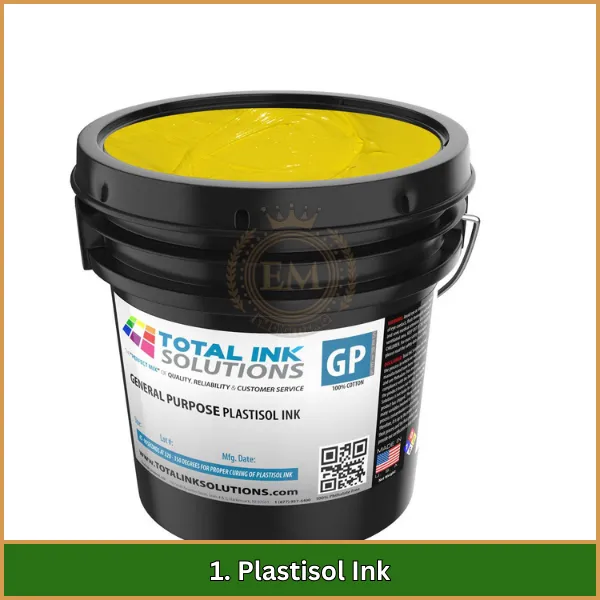
Plastisol es la tinta de serigrafía más utilizada en la industria.. es grueso, durable, e ideal para imprimir en varios tejidos.. La tinta plastisol permanece en la superficie de la tela., proporcionando impresiones vibrantes y duraderas. This type of ink is widely used because it doesn’;No se seca en la pantalla., facilitando el trabajo durante períodos prolongados.
ventajas:
- Colores vibrantes: Las tintas Plastisol producen brillo., estampados atrevidos que destacan.
- Durabilidad: Las impresiones duran más y son altamente resistentes a la decoloración., agrietamiento, o pelar.
- Facilidad de uso: Esta tinta es fácil de usar y no se seca rápidamente., permitiendo más tiempo para trabajar.
Contras:
- No transpirable: Plastisol can feel heavy on the fabric and doesn’;No dejar pasar mucho aire..
- Preocupaciones ambientales: Ya que está hecho de PVC., it’;No es tan ecológico como otros tipos de tintas..
2. Tinta a base de agua
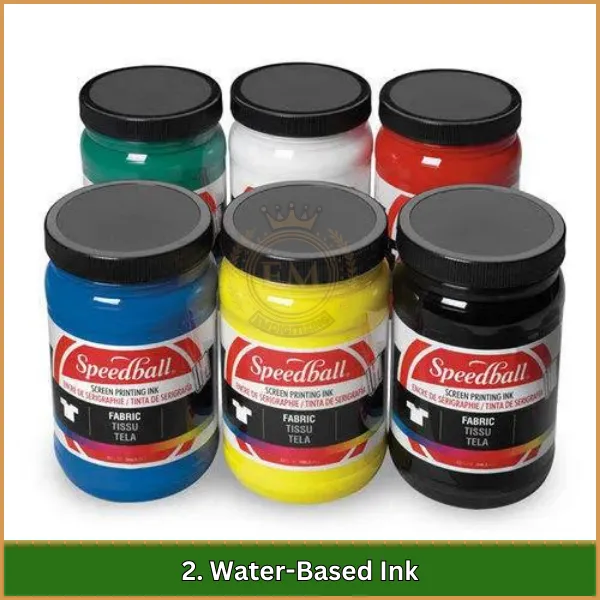
La tinta a base de agua utiliza agua como disolvente principal en lugar de productos químicos., convirtiéndolo en una opción más ecológica. Este tipo de tintas de serigrafía penetran en la tela en lugar de asentarse encima de ella., dando como resultado un acabado más suave. Son perfectos para conseguir un look natural., especialmente en telas ligeras.
ventajas:
- Sensación suave: Las tintas a base de agua se absorben en la tela., dejando una impresión ligera y suave.
- Respetuoso del medio ambiente: Contienen menos sustancias químicas nocivas y son más seguros para el medio ambiente en comparación con el plastisol..
- Ideal para tejidos ligeros: Estas tintas funcionan mejor en materiales de colores claros y proporcionan una limpieza, acabado liso.
Contras:
- Limitado a telas oscuras: Water-based inks don’;No aparece tan bien en telas oscuras a menos que se mezcle con aditivos especiales..
- Secado rápido: Suelen secarse rápidamente en la pantalla., lo que puede dificultar su uso para diseños detallados o grandes.
3. Tinta de descarga
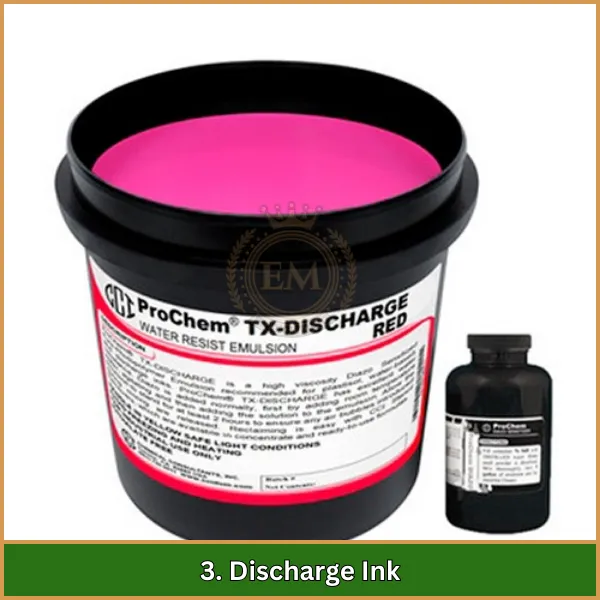
Funciona de manera diferente a la serigrafía con tinta tradicional.. En lugar de agregar color a la tela, Elimina el tinte existente y lo reemplaza con un nuevo color.. Esto hace que la tinta de descarga sea perfecta para imprimir diseños brillantes en telas oscuras., dando el aspecto de las mejores tintas de serigrafía sin aplicar demasiada tinta.
ventajas:
- Acabado suave: Como tintas a base de agua., La tinta de descarga produce una suave, estampado transpirable.
- Colores brillantes sobre telas oscuras.: Proporciona una vibrante, color de apariencia natural sobre materiales oscuros sin agregar capas pesadas de tinta.
Contras:
- Proceso complejo: La impresión por descarga requiere más experiencia y puede ser más difícil de controlar.
- Olor químico: Este tipo de tinta puede producir un fuerte olor durante el proceso de impresión..
4. Serigrafía de lámina
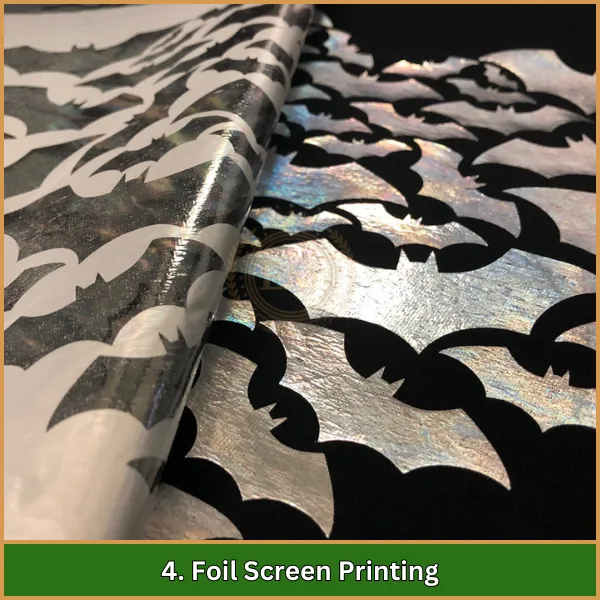
La serigrafía con papel de aluminio añade un aspecto metálico brillante a las prendas mediante el uso de una fina hoja de papel de aluminio.. El proceso comienza imprimiendo adhesivo sobre la tela y luego aplicando la lámina sobre el adhesivo.. El resultado es un reflejo, acabado brillante que le da al diseño un aspecto lujoso.
ventajas:
- Acabado brillante: La impresión con láminas proporciona una sorprendente, aspecto metálico que destaca, haciéndolo perfecto para diseños especiales.
- Aspecto único: Agrega un toque único, acabado de alta gama para productos, haciéndolos más atractivos.
Contras:
- Menos duradero: Las impresiones en papel de aluminio pueden agrietarse o pelarse con el tiempo., especialmente con lavado o uso frecuente.
- Mayor costo: Es un proceso más caro comparado con las tintas de serigrafía tradicionales..
5. Tinta Metálica

La tinta metálica se elabora mezclando pequeñas partículas metálicas con tinta estándar., dándole un reflejo, apariencia brillante. Esta mejor tinta de serigrafía se usa comúnmente para crear efectos especiales o impresiones decorativas que deben destacarse..
ventajas:
- Aspecto brillante: La tinta metálica añade brillo., brillo reflectante que hace que los diseños sean llamativos.
- Durabilidad: Las impresiones metálicas tienden a durar más y mantener su apariencia vibrante..
Contras:
- Tinta más espesa: Las partículas metálicas hacen que la tinta sea más espesa., lo que puede provocar una textura más áspera en la tela.
Uso limitado: La tinta metálica no funciona bien con todos los tipos de telas y puede requerir técnicas específicas para su aplicación..
Factores a considerar al elegir las tintas de serigrafía adecuadas para su proyecto
Elegir la tinta adecuada para serigrafía implica comprender varios factores clave para garantizar que obtenga los mejores resultados para su proyecto.. Estos son los aspectos importantes a considerar:
1. Tipo de sustrato
El tipo de material en el que se imprime juega un papel importante a la hora de seleccionar la tinta adecuada.. La tinta de serigrafía para telas como Plastisol funciona bien en algodón y poliéster., mientras que las tintas a base de agua son ideales para fibras naturales como el algodón y la seda..
2. Requisitos de diseño
- Color vibrante: Para colores brillantes, Las tintas a base de agua son excelentes para un acabado vibrante.. Para telas más oscuras, Las tintas Plastisol proporcionan mejor cobertura y opacidad..
- Nivel de detalle: Si tu diseño tiene detalles intrincados, Las tintas especiales, como las metálicas o las tintas puff, pueden necesitar técnicas y tamaños de malla específicos para obtener mejores resultados..
3. Método de curado
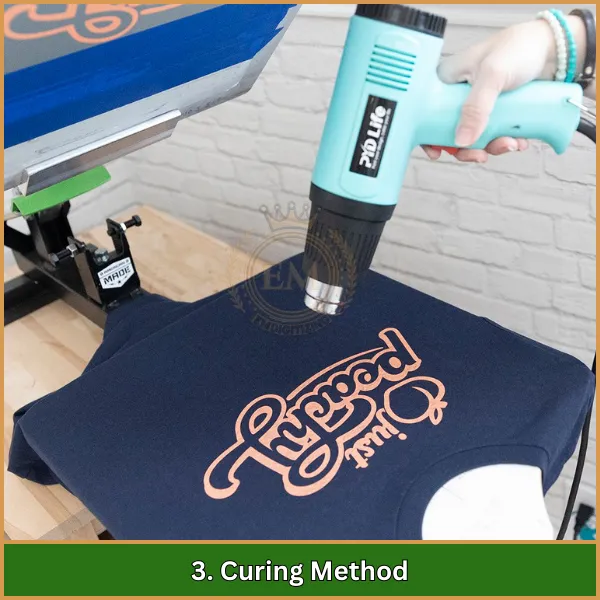
Diferentes tintas requieren diferentes métodos de curado. Las tintas Plastisol curan a temperaturas más bajas., haciéndolos adecuados para materiales sensibles al calor.
Tintas a base de agua, por otra parte, A menudo requieren temperaturas más altas y tiempos de curado más prolongados..
4. Durabilidad y longevidad
Al elegir tinta, considere cuánto tiempo debe durar la impresión. Busque tintas que sean resistentes a la luz ultravioleta., humedad, y usar, especialmente si el artículo estará expuesto a los elementos.
5. Consideraciones ambientales
Si la sostenibilidad es importante, seleccione tintas con compuestos orgánicos bajos en volátiles (COV) o formulaciones ecológicas para cumplir con las regulaciones ambientales y reducir su huella de carbono..
6. Rentabilidad
Considere no sólo el precio de la tinta sino también su eficiencia.. Algunas tintas pueden tener un costo inicial más alto, pero ahorrarán dinero a largo plazo debido a un menor consumo o reducción de desperdicios..
7. Consistencia del color

Asegúrese de que la tinta proporcione un color uniforme en todas las tiradas de impresión.. Realice pruebas de coincidencia de colores para garantizar que la tinta funcione bien con su sistema de gestión del color para obtener resultados precisos..
¿Cuáles son las aplicaciones de la serigrafía en diferentes industrias??
La serigrafía se utiliza ampliamente en diversas industrias debido a su versatilidad y capacidad para producir impresiones de alta calidad.. Aquí están las aplicaciones clave en diferentes sectores.:
1. Industria de la confección

- Camisetas y ropa: La serigrafía se utiliza habitualmente para personalizar camisetas., sudaderas con capucha, y otras prendas. Las tintas Plastisol son populares por su durabilidad y colores vibrantes., haciéndolos perfectos para ropa que se lava y usa con frecuencia.
- Ropa Promocional: Las empresas utilizan la serigrafía para prendas de vestir de marca, como uniformes y obsequios, porque la tinta garantiza diseños atractivos y duraderos..
2. Accesorios textiles
- Bolsas y Gorras: La serigrafía se utiliza en accesorios como bolsos de mano., tapas, y calcetines, Proporcionar calidad constante en diferentes materiales..
3. Publicidad y Márketing
- Pancartas y Señalización: La serigrafía se utiliza para crear pancartas vibrantes, banderas, y señalización para eventos. La durabilidad de las tintas plastisol las hace ideales para uso en exteriores..
- Exhibidores de punto de venta: Los minoristas utilizan la serigrafía para crear exhibidores atractivos que capten la atención del cliente y promocionen los productos..
4. Decoración del hogar

Textiles: La serigrafía se aplica a textiles para el hogar como cortinas., cojines, y manteles, permitiendo diseños personalizados que realzan los interiores del hogar.
5. Aplicaciones industriales
- Ropa de seguridad: Se utilizan tintas funcionales especiales en prendas de seguridad para garantizar una alta visibilidad y cumplir con los estándares de seguridad., a menudo con propiedades reflectantes.
- Etiquetas de productos: La serigrafía se utiliza para etiquetas duraderas en productos industriales que pueden soportar condiciones duras..
6. Productos especiales
- Ropa deportiva: Se utilizan tintas especiales en ropa deportiva para brindar flexibilidad y transpirabilidad mientras se mantiene vibrante., colores duraderos.
- Artículos promocionales: Las tintas se aplican a artículos como bolígrafos., llaveros, y alfombrillas de ratón para fines de marca y marketing.
7. Embalaje
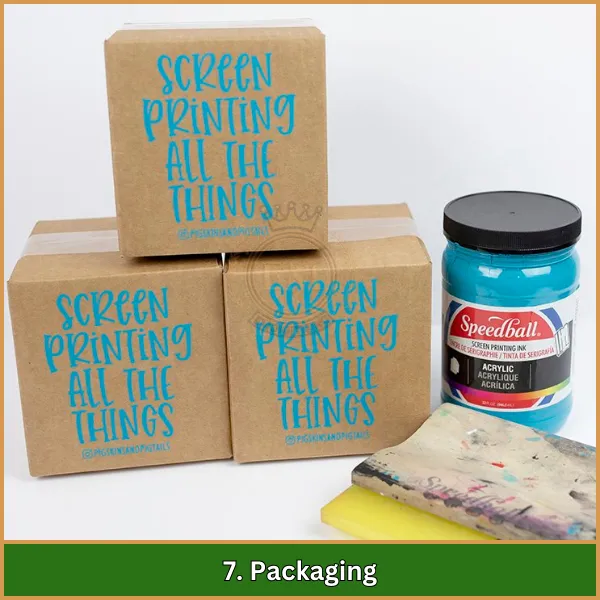
- Envasado de alimentos: Tintas especiales formuladas para materiales de embalaje., asegurando que sean seguros para el contacto con alimentos manteniendo al mismo tiempo impresiones de alta calidad.
Conclusión
En resumen, Seleccionar las tintas de serigrafía adecuadas es clave para producir alta calidad., impresiones duraderas. Conociendo los distintos tipos de tinta y sus aplicaciones., puedes asegurarte de que tus diseños luzcan vibrantes, claro, y profesional en cualquier material. La elección correcta de la tinta marcará una gran diferencia en la apariencia general y la durabilidad de sus impresiones..
Para que tus diseños sean aún más precisos y estén listos para serigrafía, EMdigitalización ofrece servicios expertos en arte vectorial. Nuestro equipo se asegura de que su obra de arte esté perfectamente preparada para obtener resultados de impresión nítidos y detallados.. Más, como cliente por primera vez, puedes disfrutar de un 50% descuento en nuestro servicios de arte vectorial. Aprovecha esta gran oferta para potenciar tus proyectos de impresión con diseños de primera calidad!
preguntas frecuentes
Para limpiar la tinta de una pantalla de serigrafía, raspar el exceso de tinta, luego use un limpiador de pantalla o un removedor de emulsión hecho para serigrafía. Enjuágalo bien con agua para eliminar los restos de tinta..
Sí, Puedes utilizar tinta de impresión para la impresión en bloque., pero su espesor y tiempo de secado pueden ser diferentes a los de las tintas de impresión en bloque normales., lo que podría afectar la calidad de la impresión.
Sí, Puede aplicar capas de tinta para serigrafía aplicando diferentes colores en pasadas separadas.. Asegúrese de que cada capa se seque por completo antes de agregar la siguiente para evitar que se mezclen los colores..
Sí, puedes pintar con tinta de imprenta, pero está hecho específicamente para serigrafía., por lo que es posible que no funcione como las pinturas tradicionales en diferentes superficies..
